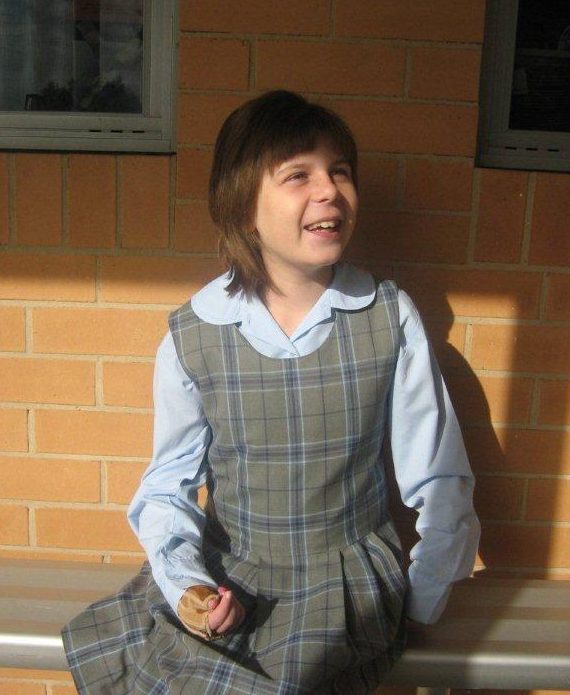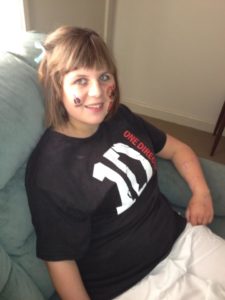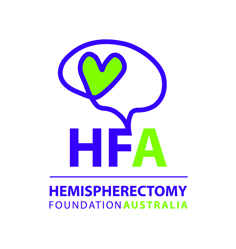
Hemi Hero: Alicia
We live in Lake Macquarie area, near Newcastle NSW and have 2 boys aged 19 and 20 and Alicia who is 13. Our beautiful daughter was born in 2000 with Erbs Palsy of the left arm and at 3 mths old she was diagnosed with Cerebral Palsy specifically right spastic hemiplegic (caused by an in-utero bleed on the brain). This meant the function of the right side of her body was affected, mainly her arm, hand, leg and foot as well as learning. With constant therapy and early intervention since birth, Alicia was able to achieve most of the normal milestones and was a very happy full of life child, not letting the CP stop her from doing anything.
By the age of 5, although she still had limited function to the right side of her body, she was living a full healthy almost normal life and the future looked promising, until one morning in 2005 she had her first seizure at home. We had been warned by the doctors that epilepsy could be associated with Cerebral Palsy due to the damage in the brain, but after 5 years of no seizures we thought that Alicia was going to be one of the lucky ones. At first we thought it was just a one off seizure as she was unwell at the time and the doctors in emergency thought the same. However, she had more seizures over the next few days and after consulting with her neurologist and undergoing tests, she was diagnosed with Epilepsy and prescribed Epilim. Initially she was only having 1-2 seizures early morning which lasted from 10-30 seconds after which she would sleep for a short time and would be right for the rest of the day. She remained upright during the seizures, became unfocused, her head would turn to the right and her right arm would become outstretched and stiff, and she would make moaning noises.
The Epilim controlled the seizures for about 3 mths but then despite trying various medications and alternative therapies over the next 5 years, the seizures were unable to be controlled. We tried to live as normal a life as possible but Alicia’s seizures were increasing in symptoms and quantity. Most of them were reflex seizures which meant they were triggered by anything which could startle her, ranging from unexpected movements around her or noises. She also had laughing seizures where she would start laughing for no reason and had no control over it. Another type of seizure we called the “Floppsies” where her body would go limp for about 2 hours and all she could do was lie down. As her seizures could never be predicted and she was sustaining injuries on a daily basis, including concussions, broken bones and damaged teeth, we felt the safest place for her was in a wheelchair. Despite being able to walk and run and do most activities her peers could do, she became confined to the wheelchair at school and anywhere away from home, when we were not there to physically support her. She also became incontinent with the seizures requiring her to wear incontinent underwear 24 hours a day. If she had a seizure at school, she would need to change the underwear which required assistance from the aide. She was regularly late for school after having a seizure and needing a nap. I was often called to the school to collect her as she had become too tired from seizures or was having too many at school. At home and at school we installed “octopus arms” on the toilets which prevented her from falling of the toilet when she had a seizure. She had to shower sitting down for safety and rode a modified bike with a harness to prevent falling off. Our life revolved around her seizures and we often had to cancel plans. One of us had to be with her 24/7 and she had to follow strict rules about what she could and couldn’t do, to ensure her safety. When we went anywhere she wanted to wear earplugs or headphones so that sudden noises wouldn’t startle her and trigger a seizure. On the worst days she was having about 20 seizures which left her exhausted for a couple of days.
From a young age Alicia exhibited behaviour issues associated with the brain damage which became exacerbated by the seizures and medication she was on. Her behaviour at home became uncontrollable and she would have violent and aggressive tantrums, hitting out at anyone or anything that was close to her. She would throw things around the house and kick her bedroom walls and doors, when we put her in there to calm down. She would carry on like this until she was exhausted, sometimes up to an hour, only being consoled by hugging her tightly and rocking, then she would sleep. When she woke she was unable to explain her behaviour and would hate herself for how she behaved. She would have “meltdowns” about the simplest of things so we had to be wary of what we said and did with her. The medication also affected her appetite, suppressing it to the point that she was only eating 2 weetbix daily and anything else we could bribe her with, usually junk food. She became almost anorexic looking and her appetite and health became another concern for us.
The epilepsy was also affecting her learning. She was constantly fatigued from seizures, had poor concentration at school and was learning very little. The doctors indicated that she was unlikely to outgrow the epilepsy or control it with medication. It was highly likely that the epilepsy would worsen during puberty and the long term affects of the seizures to her brain would be debilitating. The muscle tone in the right side of her body had also increased with the epilepsy, causing her foot to become deformed and therapy less effective. As a result she required surgery to correct her foot.
We all felt like we were living in a nightmare and knew that we, especially Alicia couldn’t continue life this way. The future looked bleak for us all. It was clear that we had to look at other ways of controlling the epilepsy, and brain surgery was suggested. In 2009 Alicia underwent further tests to obtain more detailed information about the seizures. After viewing the results of these tests the doctors indicated that brain surgery may be an option to eliminate the seizures. We thought this was too drastic but decided that we had nothing to lose by finding out about it. After all, they couldn’t do it unless we gave them permission and as far as we were concerned that wasn’t going to happen.
At our first appointment with the brain surgeon Dr Mark Dexter, everything was explained to us and he believed that the surgery would have a 90% chance of being successful. Although, the surgery would result in the loss of right peripheral vision and further loss of the function of the right side of her body, with speech and eating also possibly affected. We thought that there must have been another alternative, so for the next 12 mths I thoroughly researched alternatives which also looked grim. It gradually appeared that the brain surgery was going to be the best option to totally eliminate the seizures. We had decided to view this option, not as brain surgery but as the option that had the highest percent of success, while still allowing her a better quality of life. When we looked at it that way it seemed the obvious choice, but it was till very scary.
By now Alicia was 10 yrs old so we explained to her that the doctors could perform an operation on her brain which could stop the seizures. We didn’t give her any more information than this at this stage as we thought it would be too overwhelming for her. The idea scared her and at first she didn’t want to do it, but after talking some more to us about it she decided that she wanted to do it. This was in September 2010 and Alicia underwent a left hemispherectomy on 26 October 2010. Immediately after the 9 hr surgery Dr Dexter informed us that it was a “routine surgery” and everything went well. She was in ICU for about 3 days where she spoke her first words after the surgery. Although it was slightly slurred she spoke well. As predicted her right arm and leg were limp and she couldn’t move them, but all other parts of her body seemed to be functioning properly. She was transferred to a ward and over the following weeks she was eating normally and slowly regaining limited function of her right limbs with daily therapy. She was in hospital for 9 weeks all up, and was walking with a limp by the time we left. There was a slight complication of a staph infection in the surgery wound which required re-admittance to hospital and IV antibiotics for 8 weeks, but this was resolved and therapy continued.movie Fifty Shades Darker 2017
By Feb 2011 she was swimming independently in our new pool. Alicia had been doing swimming lessons since she was three and was quite good in the water, so it was wonderful to see her regain these skills. She returned to school in the wheelchair for ½ days as she was till fatiguing easily but resumed full time school by Term 2 and coped with it well. She continued to use the wheelchair at school as walking around all day made her tired and was still quite unstable on her leg. By March 2011 she was able to join a soccer team, something she’d always wanted to play, but prior to the competition starting she fell over and broke her arm. Not one to let anything keep her down, after 6 weeks she was out on the field running around. Her right leg was still weak and she fatigued easily, so 10 minutes on the field was enough for her. She still couldn’t run so she walked around the field and I think she only touched the ball twice throughout the whole season, but she loved it. She was also able to play in the school netball team, and participate in sport for the first time unaided, albeit with adjustments.
We live near the beach so she’d grown up loving the surf despite everything and was able to handle herself in the waves independently prior to the surgery. We regularly took her to the beach throughout 2011 after the surgery and this helped her regain her abilities and strength. She also joined Nippers at our local surf club which she loves, and she was soon back out there independently swimming amongst the waves. This year we are going to help her to ride a boogie board. She still can’t use her right hand so we have a board with a handle strap at the front she can hold onto with her left hand (inspired by one armed surfer Bethany Hamilton). In 2012 she underwent limb lengthening procedure to her non-hemiplegic left arm (one of the forearm bones had not grown due to dysfunctional growth plate and was causing deformity in this arm and hand). The procedure took 9 mths so she was unable to participate in any physical activities and confined to a wheelchair to reduce the risk of falling over and doing damage to the metal apparatus in the arm. As she spent so much time in the wheelchair she lost a lot of strength and function in her leg that we had achieved. The procedure was finalized in April this year and with exercsie and therapy every day she has regained the strength and function. She still needs the wheelchair for long distances and all day at school, but she is able to walk independently most places and is starting to walk more at school. Last term she started to catch the school bus home from school and is now able to do it totally independently. Our aim is that she will catch the bus every day to and from school and one day not need the wheelchair to get around the school.
The only thing that hasn’t improved significantly is her learning. She is definitely more alert and concentration is better but her cognition and processing is moderately delayed. . She is in YR 7 and attends a mainstream Catholic school where she participates in mainstream classes with support and modifications. Her learning ability is about YR 4-5 and she will probably eventually start on the Life Skills Program in the higher grades. The transition from primary to high school has gone amazingly well, and she has loved high school from the first day with every day either being good, great or awesome. The only subjects she doesn’t participate in are the rotational classes of woodwork and metal work due to safety issues and the practicality of needing 2 hands. Instead, she does extra literacy and maths work as she still struggles with the basics in these subjects. She has used a computer and Ipad at school since Yr 3 as her writing skills have not progressed past Kindy level. She loves to write so she does sometimes write short bits of information in her books at school. She knows her way around a computer and Ipad well and likes to use them for the same enjoyment as her peers do, not just for school work. In class she needs to sit at the front with the left side closest to looking at the board, due to loss of right peripheral vision. Up until recently she required glasses, but her vision has improved so doesn’t need them anymore. We had her assessed for prism glasses to enhance the right peripheral vision but the specialist recommended she continue without them as she has adjusted well to this loss, and it is not negatively impacting her life.
Speech therapy is still a part of her life. Not so much for actual speech sounds but more for receptive and expressive language. Her actual speech is almost normal but she finds it hard to coherently convey information or a story. Although she is below her reading level, this has improved significantly with daily reading programs at school and home, and can now read most things she comes across in her daily life.
Alicia lives an active fulfilling life and tells us all the time how much she loves life and that she has a great life. We don’t let her disability stand in the way of her wanting to do something. If she wants to do something we can usually find a way. She leads an almost normal life of a 13 yr old girl with similar attitudes and interests – likes to hang out with her friends, listening to music, talking about boys and doing whatever her friends are doing. As she is becoming more and more independent she is doing more with her friends without us.
She still has limited function of her right hand, but is able to use her arm for support when she is reminded to do so. We continue to do therapy with it in the hope that over time her right hand will become more useful. If not there are an amazing array of devices out there designed to assist one handed people. Despite the losses caused by the surgery, Alicia’s quality of life is so much better without the seizures. She is loving and life and is a very happy person.

